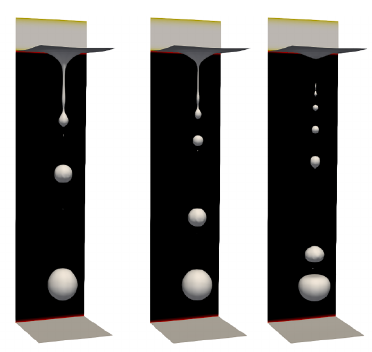
R. Zanella, R. Le Tellier, Mathis Plapp1, György Tegze2, Hervé Henry1
1Laboratoire Physique de la Matière Condensée, École Polytechnique, CNRS, Université Paris-Saclay, 91128 Palaiseau Cedex, France
2Institute for Solid State Physics and Optics, Wigner Research Centre for Physics, P.O. Box 49, Budapest H-1525, Hungary
During a severe accident in a nuclear reactor, the melting of the core may lead to the formation of a multiphase liquid pool (corium) in the vessel lower head. The heat transfer at the boundary with the vessel is affected by diffusive and convective mass fluxes. In particular, the development of Rayleigh–Taylor instabilities influence the thickness of the top metallic layer and therefore the “focusing effect” of the heat flux, which is the main risk for the vessel integrity. We use a Cahn–Hilliard pseudo-binary model to describe the uranium/oxygen/zirconium/iron mixture. The diffusion and the convection are governed by the Cahn–Hilliard equation and the Navier–Stokes equations under the Boussinesq approximation. In this work, the model is isothermal and the buoyancy force is only due to the gradient of chemical composition. The model is solved in three dimensions with a pseudo-spectral code. The initial configuration consists of a light layer of iron-rich fluid above a heavy layer of uranium/oxygen/zirconium mixture. A thin layer of heavier metallic phase lays at the interface and eventually triggers a Rayleigh–Taylor instability. The metallic phase forms a plume which falls downward and then breaks up into droplets due to the Rayleigh-Plateau instability. The phenomenon is alimented by diffusion which generates the heavy metallic phase at the interface. The droplet formation observed in an experiment of corium stratification transient from the literature is qualitatively captured. The mobility, the viscosity and the surface tension are shown to have an influence on the mass transfer.


